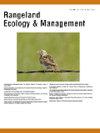The Carbon Security Index: A Novel Approach to Assessing How Secure Carbon Is in Sagebrush Ecosystems Within the Great Basin
IF 2.4
3区 环境科学与生态学
Q2 ECOLOGY
引用次数: 0
Abstract
Rangeland carbon is often conceptualized similarly to intensively managed agricultural lands, in that we need to sequester and store more carbon. Unlike intensively managed agricultural lands, rangeland soils cannot sequester more carbon due to pedogenic and climatic limitations that influence plant community and microbial community dynamics. This requires a new paradigm for rangeland carbon that focuses on maintaining carbon security following disturbances like fire and plant community conversions (e.g., annual grasslands and conifer woodlands). To attain this, we propose the creation of a Carbon Security Index (CSI). CSI is a unitless, scalable value that can be used to compare carbon security across rangeland sites and over time and incorporates a plant fractional cover ratio, resistance and resilience, and wildfire probability. Using the Great Basin as a case study, we found that CSI decreased by 53% basin wide from 1989 to 2020. Using the Sagebrush Conservation Design's sagebrush ecological integrity categories across the Great Basin, we found that CSI in “core” areas remained relatively unchanged between 1998 and 2020 (decreased by 1%), whereas “growth opportunity” areas CSI began to change (decreased by 13%) and “other rangeland” areas CSI decreased by 67%. We found that CSI was able to act as an indicator for determining when carbon security would decrease several years prior to a wildfire disturbance, which then rapidly reduced CSI. Finally, we created a carbon security management map to help prioritize potential management for achieving greatest carbon security and locations for restoration. These results show that CSI provides landowners and land managers an opportunity to assess how secure their carbon is on the land and help them prioritize areas for restoration.
碳安全指数:评估大盆地内沙棘生态系统碳安全程度的新方法
牧场碳的概念通常与集约化管理的农业用地类似,即我们需要固存和储存更多的碳。与集约化管理的农田不同,牧场土壤由于受到影响植物群落和微生物群落动态的成土和气候限制,无法固存更多的碳。这就需要一种新的牧场碳模式,重点是在火灾和植物群落转换(如一年生草地和针叶林地)等干扰后保持碳安全。为此,我们建议创建碳安全指数(CSI)。碳安全指数是一个无单位、可扩展的数值,可用于比较不同牧场和不同时期的碳安全状况,并包含植物部分覆盖率、抵抗力和恢复力以及野火概率。以大盆地为例,我们发现从 1989 年到 2020 年,整个盆地的 CSI 下降了 53%。利用 "灌木丛保护设计 "对整个大盆地的灌木丛生态完整性进行分类,我们发现 1998 年至 2020 年期间,"核心 "地区的 CSI 保持相对不变(下降了 1%),而 "增长机会 "地区的 CSI 开始发生变化(下降了 13%),"其他牧场 "地区的 CSI 下降了 67%。我们发现,在野火肆虐的前几年,CSI 可以作为判断碳安全度何时下降的指标,野火肆虐后,CSI 会迅速下降。最后,我们绘制了一张碳安全管理地图,以帮助确定实现最大碳安全的潜在管理和恢复地点的优先顺序。这些结果表明,CSI 为土地所有者和土地管理者提供了一个评估土地碳安全程度的机会,并帮助他们确定恢复区域的优先顺序。
本文章由计算机程序翻译,如有差异,请以英文原文为准。
求助全文
约1分钟内获得全文
求助全文
来源期刊

Rangeland Ecology & Management
农林科学-环境科学
CiteScore
4.60
自引率
13.00%
发文量
87
审稿时长
12-24 weeks
期刊介绍:
Rangeland Ecology & Management publishes all topics-including ecology, management, socioeconomic and policy-pertaining to global rangelands. The journal''s mission is to inform academics, ecosystem managers and policy makers of science-based information to promote sound rangeland stewardship. Author submissions are published in five manuscript categories: original research papers, high-profile forum topics, concept syntheses, as well as research and technical notes.
Rangelands represent approximately 50% of the Earth''s land area and provision multiple ecosystem services for large human populations. This expansive and diverse land area functions as coupled human-ecological systems. Knowledge of both social and biophysical system components and their interactions represent the foundation for informed rangeland stewardship. Rangeland Ecology & Management uniquely integrates information from multiple system components to address current and pending challenges confronting global rangelands.
 求助内容:
求助内容: 应助结果提醒方式:
应助结果提醒方式:


